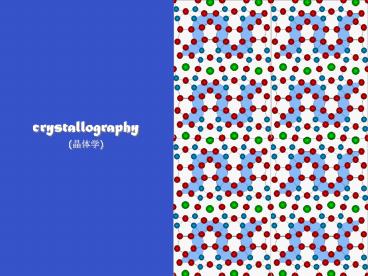crystallography - PowerPoint PPT Presentation
Title:
crystallography
Description:
object with 4-fold symmetry translates OK. overlap not allowed. object with 5-fold symmetry doesn't translate. Periodicity and rotational symmetry ... – PowerPoint PPT presentation
Number of Views:104
Avg rating:3.0/5.0
Title: crystallography
1
crystallography (???)
2
Structure is important Type of structure we
discussed called crystal structure
(????) In crystals, atom groups (unit cells) are
repeated to form a solid material
3
Structure is important "X-ray diffraction" is
important method for study of materials
X-ray diffraction works because of the
repeating nature of crystals
To understand X-ray diffraction, must
first understand repetition in crystals
The study of repetition in crystals is called
crystallography
4
Repetition symmetry (???)Types of
repetition Rotation (??) Translation (??)
5
RotationWhat is rotational symmetry?
6
Imagine that this object will be rotated (maybe)
7
Imagine that this object will be rotated (maybe)
8
Imagine that this object will be rotated (maybe)
9
Imagine that this object will be rotated (maybe)
10
Was it?
11
The object is obviously symmetricit has symmetry
12
The object is obviously symmetricit has
symmetryCan be rotated 90 w/o detection
13
so symmetry is really
doing nothing
14
Symmetry is doing nothing - or at least doing
something so that it looks like nothing was done!
15
What kind of symmetry does this object have?
16
What kind of symmetry does this object have?
4 (???)
17
What kind of symmetry does this object have?
4
m (?)
18
What kind of symmetry does this object have?
4
m
19
What kind of symmetry does this object have?
4
m
20
What kind of symmetry does this object have?
4
4mm (??)
m
21
Another example
22
Another example
6
6mm
m
23
And another
24
And another
2
2
25
What about translation?Same as rotation
26
What about translation?Same as rotationEx
one dimensional array of points
Translations are restricted to only certain
values to get symmetry (periodicity)
27
2D translationsLots of common examples
28
Each block is represented by a point
29
This array of points is a LATTICE (??)
30
Lattice - infinite (???), perfectly periodic
(????) array of points in a space
31
Not a lattice
32
Not a lattice
33
Not a lattice - .some kind of STRUCTURE because
not just points
34
Another type of lattice - with a different
symmetry rectangular
35
Another type of lattice - with a different
symmetrysquare
36
Another type of lattice - with a different
symmetry hexagonal
37
Back to rotation - This lattice exhibits 6-fold
symmetry hexagonal
38
Periodicity and rotational symmetryWhat types
of rotational symmetry allowed?
object with 4-fold symmetry translates OK
object with 5-fold symmetry doesn't translate
39
Periodicity and rotational symmetrySuppose
periodic row of points is rotated through ?
40
Periodicity and rotational symmetryTo maintain
periodicity
41
(No Transcript)
42
(No Transcript)
43
(No Transcript)
44
(No Transcript)
45
(No Transcript)
46
(No Transcript)
47
Basis vectors and unit cells
T t a t b
b
a
a and b are the basis vectors for the lattice
48
In 3-D
49
In 3-D
gt 221 direction
50
Lattice parameters (????)
c
b
a
b
g
a
need 3 lengths - a, b, c 3 angles -
?, ?, ? to get cell shape
51
The many thousands of lattices classified into
crystal systems (??)
System Interaxial Axes
Angles Triclinic a ? b ? g
? 90 a ? b ? c Monoclinic a
g 90 ? b a ? b ? c Orthorhombic a
b g 90 a ? b ? c Tetragonal
a b g 90 a b ? c Cubic
a b g 90 a b
c Hexagonal a b 90, g 120 a
b ? c Trigonal a b 90, g 120 a
b ? c
52
(No Transcript)
53
(No Transcript)
54
When choosing unit cell, pick Simplest,
smallest Right angles, if possible Cell
shape consistent with symmetry
55
Which one? Why?
56
(No Transcript)































